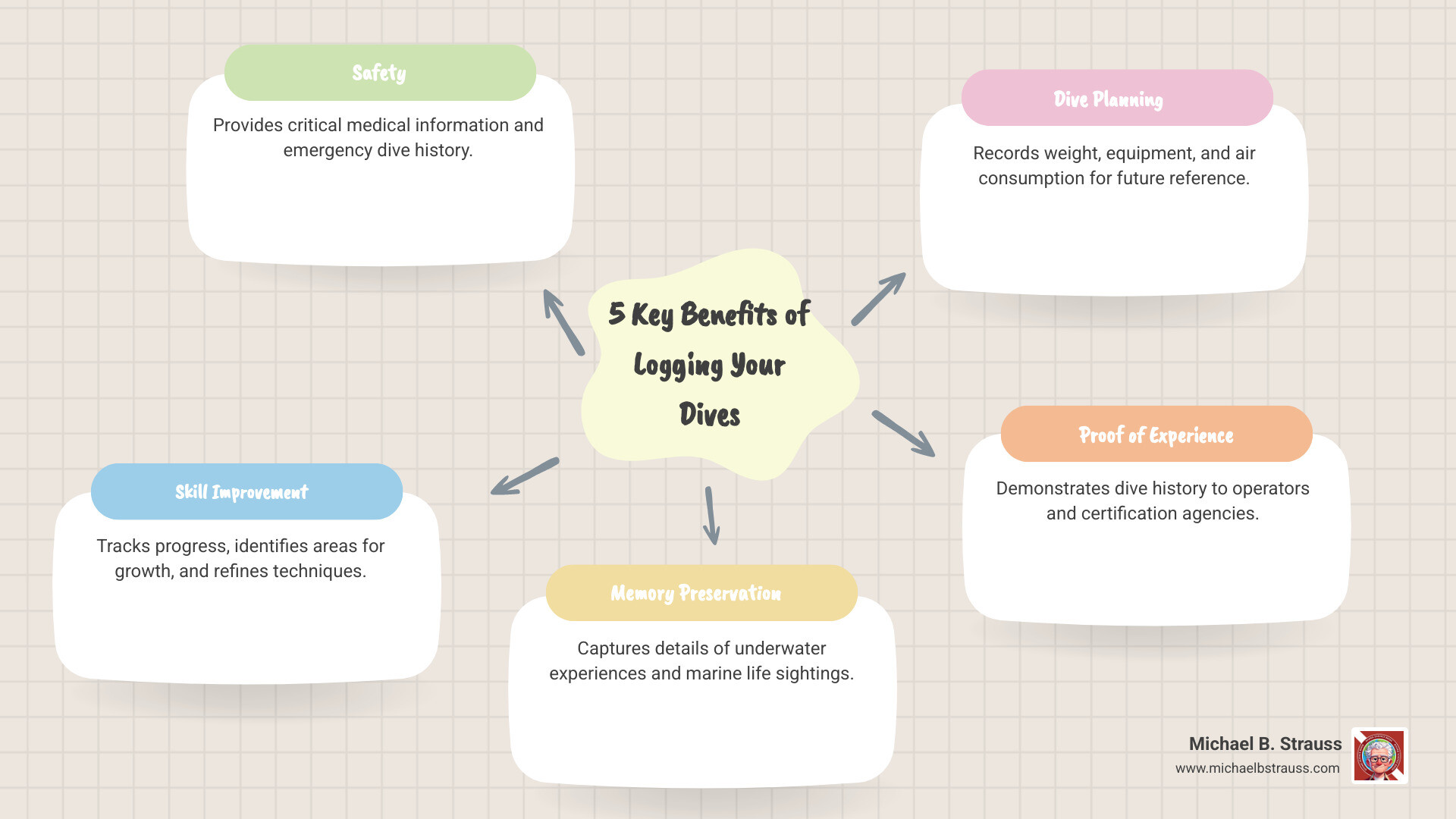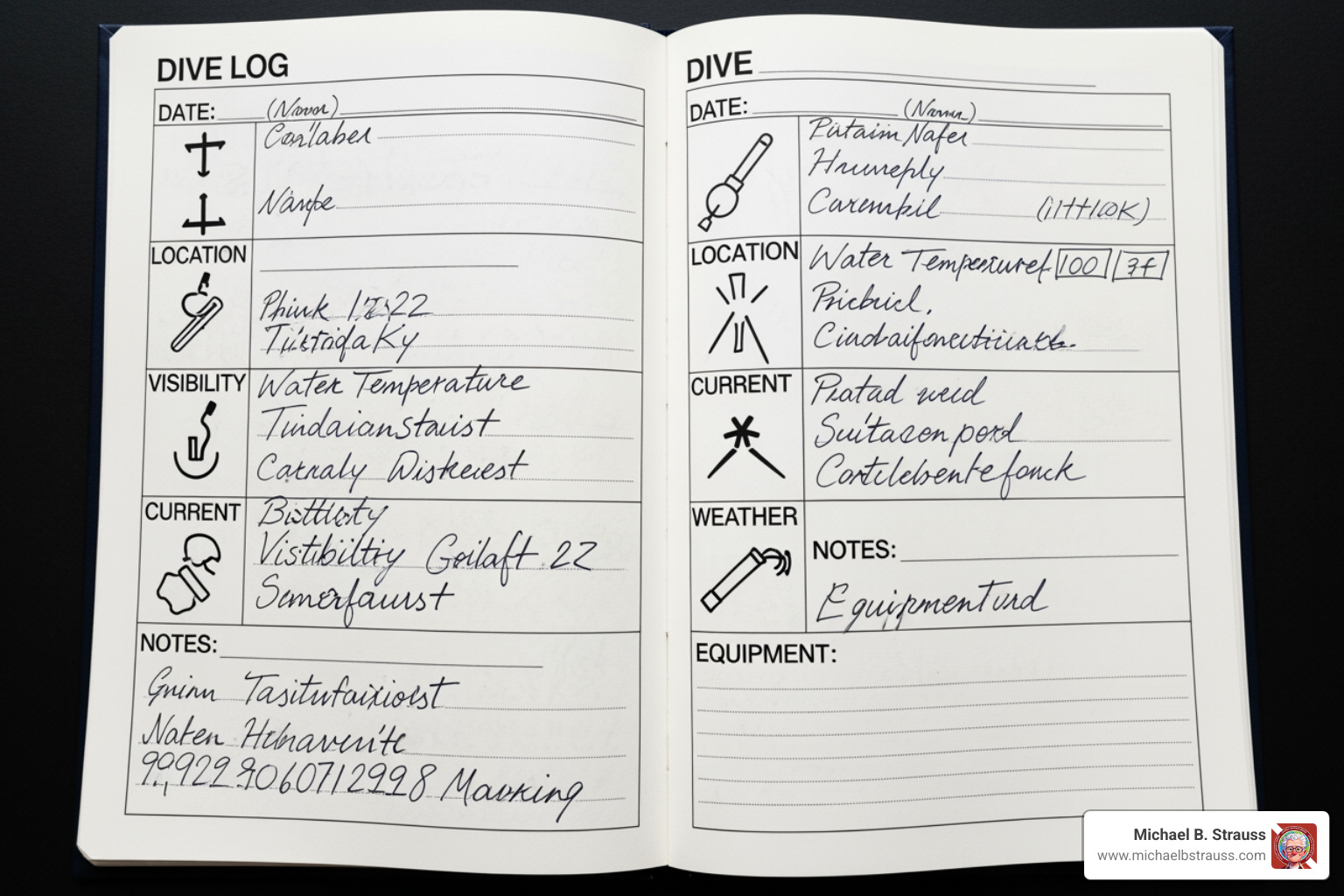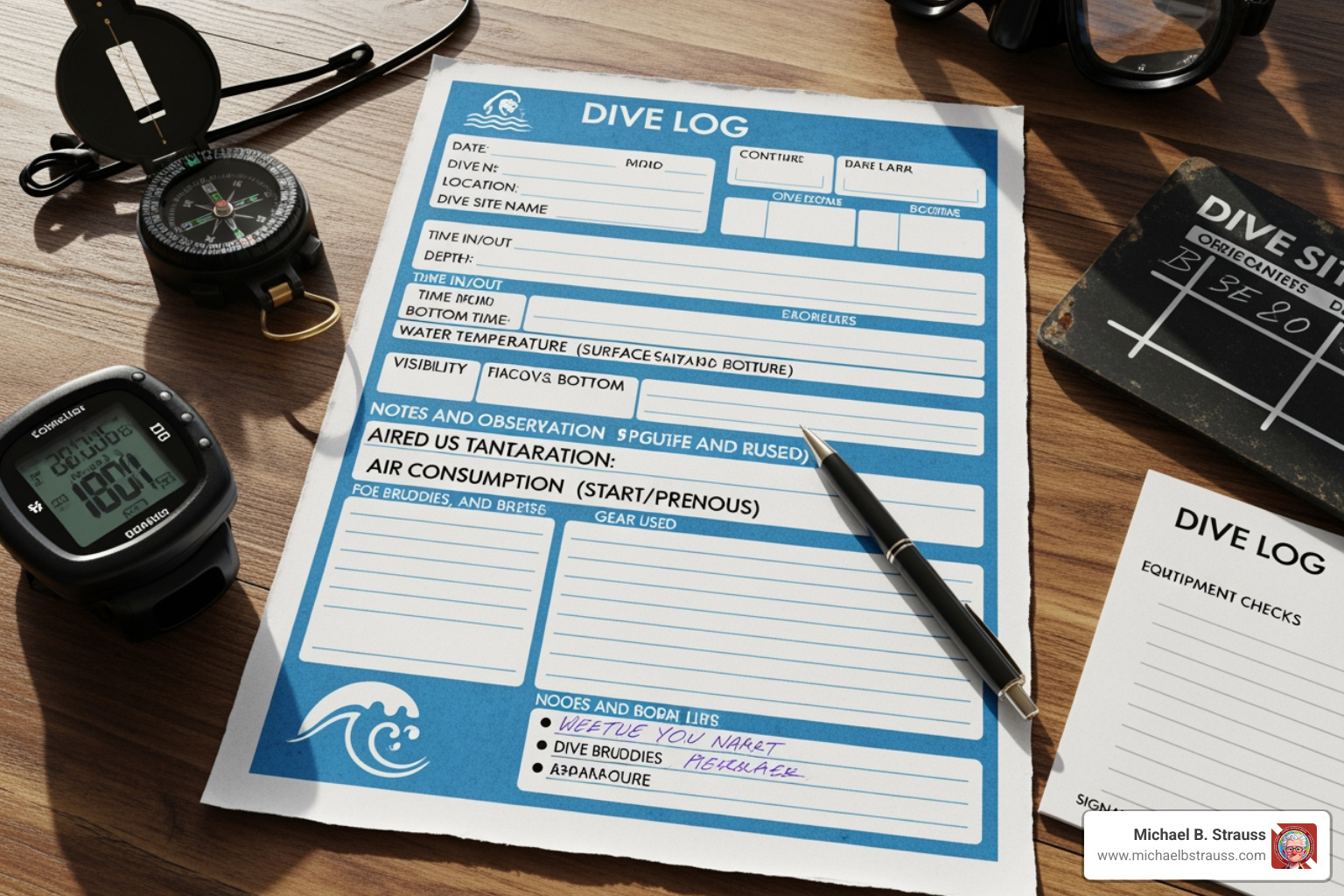Why Every Diver Needs a Reliable Dive Log Template
A dive log template is a structured document—digital or printable—that helps you record essential information about every dive. While it's easy to let the habit slide, a well-kept log is your underwater resume, safety backup, and memory keeper all in one. It proves your experience to dive operators, provides critical data for medical professionals in an emergency, and helps you track your progress to become a better diver.
Whether you're a recreational diver or a technical one, the right template makes all the difference.
Quick Access to Templates:
- Basic Repetitive Dive Template - Best for recreational divers tracking standard information.
- Advanced Multi-Level/Nitrox Template - Designed for technical divers who need to log gas mixes and complex profiles.
- Custom Editable Templates - Personalize Word or PDF formats with your own fields.
- Standard Printable Pages - Print four log entries per double-sided 8.5" x 11" sheet.

Dive log template vocab explained:
Your Ultimate Guide to Using a Dive Log Template
This section will walk you through choosing, using, and customizing dive logs to perfectly suit your underwater adventures.
The Critical Role of a Dive Log: More Than Just a Notebook
A well-maintained dive log template is one of the most valuable tools in your gear bag. It serves as your underwater resume, verifying your experience for dive operators. In an emergency, it becomes a critical medical document, providing your dive profile to professionals for accurate diagnosis and treatment. For anyone interested in the science behind this, understanding decompression science shows just how important accurate logging is.
Your log is also a personal classroom. By recording details like weight used, exposure suit type, and air consumption, you can spot patterns, fine-tune your gear, and improve your skills. Calculating your Surface Air Consumption (SAC) rate from this data acts like a fuel gauge, making your dive planning safer and more precise.
Finally, it's a tool for memory preservation. Writing down what you saw and felt—a curious octopus, a circling school of barracuda—cements those fleeting moments. It also serves as a debriefing tool, helping you analyze what went well and what could be improved, turning every descent into a lesson.
Anatomy of a Perfect Dive Log Entry
A good log entry captures what matters without getting bogged down in unnecessary detail. While every dive log template varies, these fields are universally important for safety, planning, and memories.

- Dive Number and Date: Creates a chronological timeline of your diving history and total experience.
- Location and Dive Site: "Palancar Caves, Cozumel" is far more useful than just "Cozumel." GPS coordinates are a bonus for finding a site again.
- Conditions: Water temperature, visibility, and current paint a picture of the dive and help you plan for similar conditions in the future.
- Gear Configuration: Note your exposure suit, tank type, and weight used. This is your reference guide for dialing in your buoyancy and trim.
- Dive Profile: Maximum depth and total bottom time are essential for decompression calculations and proving experience for advanced courses.
- Gas Management: Recording your starting and ending tank pressure helps you calculate your air consumption rate. For nitrox divers, logging your gas mix is critical for safety.
- Verification: A signature from your buddy or dive operator verifies the dive for certifications and adds a personal touch to your record.
- Notes and Sightings: This is where your log comes alive. Sketch a map, describe a rare fish, or note a new skill you practiced. This section turns data into a story.
Paper vs. Digital: Finding Your Perfect Logging Method
The choice between a traditional paper logbook and a modern digital app depends on your personal style. Both have distinct advantages.
Paper logbooks offer a satisfying tactile experience. The physical act of writing can improve memory retention, and they require no batteries, making them perfect for remote locations. Getting physical stamps and signatures is simple, and many operators still prefer to see a physical book. The main downsides are their bulk and vulnerability to water damage.
Digital logs excel at data management. Many dive computers sync directly with apps, automatically uploading your profile and eliminating manual entry. You can search your entire dive history in seconds, analyze trends in air consumption, and back up your records to the cloud. However, they rely on battery power and some platforms may require a subscription.
Many divers find a hybrid approach works best: use a simple paper log for on-the-boat notes and signatures, then transfer the data to a digital system for long-term analysis and backup. The best system is the one you'll use consistently.
How to Choose and Customize Your Dive Log Template
The right dive log template should fit your experience level and diving style.
For newer recreational divers, a simple template is best. Focus on the essentials: dive number, date, location, depth, time, and air pressure. A clean layout makes logging quick and encourages consistency.
Advanced and technical divers need more detail. Look for fields for Equivalent Air Depth (EAD), oxygen exposure (CNS/OTU), multiple gas mixes, and space for multi-level profiles.
The real power comes from customization. Many templates are available as editable Word documents, allowing you to add or remove fields to suit your needs. You could add a section for photography settings, a checklist for your pre-dive safety procedures, or more space for sketching maps.
Once printed, coil binding is a great option that allows the book to lay flat. A standard three-ring binder offers maximum flexibility for adding, removing, and reorganizing pages. By choosing and customizing your template, you create a tool that genuinely serves your needs.
Download Your Free Printable Dive Log Templates
Forget expensive commercial refills. High-quality, free printable dive log template resources offer a flexible and budget-friendly solution. You can download and print exactly what you need, whenever you need it.

- For recreational divers, a basic template focuses on the fundamentals. Look for a template with a clean, straightforward layout.
- For advanced or technical diving, your logging needs are more complex. Seek out a template that includes fields for gas mixes, EAD, and oxygen exposure.
Most templates are designed for standard 8.5" x 11" paper. Many are configured to yield four log entries per sheet when printed double-sided—simply print, then cut the page in half. This saves paper and creates a compact logbook. The advantages are clear: you save money, have instant access to new pages, and can customize your logbook to perfectly match your diving journey.
Improve Your Diving Journey
Every dive you log is more than just a record—it's a step toward becoming a safer, more confident, and more knowledgeable diver. Filling out your dive log template transforms a fleeting experience into a lasting memory and a valuable lesson. Your logbook tells your story, tracks your growth, and provides the data you need to plan future adventures with confidence.
But a diver's education doesn't stop with logging. To truly understand the underwater world, we must grasp the science behind it. The expertise of Dr. Michael B. Strauss in diving safety and physiology helps explain not just what to record, but why it matters.
Continue Your Education in Diving Science
Your dive log template is a practical tool; understanding the science behind it makes you a better diver. We invite you to deepen your knowledge by exploring the comprehensive diving resources available through Dr. Strauss's work.
- Learn about decompression science to understand how pressure changes affect your body and why your dive profile is so important.
- Find why and at what sites decompression sickness can occur, reinforcing the critical need for accurate logging.
- For a broader overview, the diving science section covers the principles that inform safe diving practices.
- If you've experienced discomfort after a dive, find guidance on the evaluation and management of pain-related medical problems of diving.
By combining the habit of detailed logging with a solid understanding of diving science, you empower yourself to be a truly knowledgeable and responsible diver. Every log entry is a step in that journey, and every piece of knowledge gained makes the next dive safer and more rewarding.
To dive deeper into the science behind safe diving practices, get your copy of Diving Science Revisited today!
DISCLAIMER: Articles are for "EDUCATIONAL PURPOSES ONLY", not to be considered advice or recommendations.






